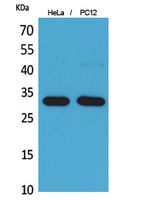CD300f Polyclonal Antibody
- Catalog No.:YT5475
- Applications:WB;IHC;IF;ELISA
- Reactivity:Human;Rat;Mouse;
- Target:
- CD300f
- Gene Name:
- CD300LF
- Protein Name:
- CMRF35-like molecule 1
- Human Gene Id:
- 146722
- Human Swiss Prot No:
- Q8TDQ1
- Mouse Gene Id:
- 246746
- Mouse Swiss Prot No:
- Q6SJQ7
- Rat Gene Id:
- 287818
- Rat Swiss Prot No:
- Q566E6
- Immunogen:
- The antiserum was produced against synthesized peptide derived from the Internal region of human CD300LF. AA range:41-90
- Specificity:
- CD300f Polyclonal Antibody detects endogenous levels of CD300f protein.
- Formulation:
- Liquid in PBS containing 50% glycerol, 0.5% BSA and 0.02% sodium azide.
- Source:
- Polyclonal, Rabbit,IgG
- Dilution:
- WB 1:500 - 1:2000. IHC: 1:100-1:300. ELISA: 1:20000.. IF 1:50-200
- Purification:
- The antibody was affinity-purified from rabbit antiserum by affinity-chromatography using epitope-specific immunogen.
- Concentration:
- 1 mg/ml
- Storage Stability:
- -15°C to -25°C/1 year(Do not lower than -25°C)
- Other Name:
- CD300LF;CD300F;CLM1;IGSF13;IREM1;NKIR;CMRF35-like molecule 1;CLM-1;CD300 antigen-like family member F;Immune receptor expressed on myeloid cells 1;IREM-1;Immunoglobulin superfamily member 13;IgSF13;NK inhibitory receptor;CD300f
- Observed Band(KD):
- 32kD
- Background:
- This gene encodes a member of the CD300 protein family. Members of this family are cell surface glycoproteins with a single IgV-like extracellular domain, and are involved in the regulation of immune response. The encoded protein is an inhibitory receptor. Alternative splicing results in multiple transcript variants. [provided by RefSeq, Jan 2014],
- Function:
- function:Acts as an inhibitory receptor for myeloid cells and mast cells. Inhibits osteoclast formation.,PTM:Phosphorylated on tyrosine.,similarity:Belongs to the CD300 family.,similarity:Contains 1 Ig-like V-type (immunoglobulin-like) domain.,subunit:Interacts with PTPN6/SHP-1 in a tyrosine phosphorylation dependent manner.,tissue specificity:Highly expressed in spleen, peripheral blood leukocte and monocyte, and lung. Weakly expressed in thymus, heart, brain, placenta, liver, skeletal muscle, kidney, pancreas, prostate, testis, ovary, small intestine or colon. Expressed selectively in monocytes and monocyte-related cells.,
- Subcellular Location:
- Cell membrane ; Single-pass type I membrane protein .
- Expression:
- Highly expressed in spleen, peripheral blood leukocyte and monocyte, and lung. Weakly expressed in thymus, heart, brain, placenta, liver, skeletal muscle, kidney, pancreas, prostate, testis, ovary, small intestine or colon. Expressed selectively in monocytes and monocyte-related cells.
- June 19-2018
- WESTERN IMMUNOBLOTTING PROTOCOL
- June 19-2018
- IMMUNOHISTOCHEMISTRY-PARAFFIN PROTOCOL
- June 19-2018
- IMMUNOFLUORESCENCE PROTOCOL
- September 08-2020
- FLOW-CYTOMEYRT-PROTOCOL
- May 20-2022
- Cell-Based ELISA│解您多样本WB检测之困扰
- July 13-2018
- CELL-BASED-ELISA-PROTOCOL-FOR-ACETYL-PROTEIN
- July 13-2018
- CELL-BASED-ELISA-PROTOCOL-FOR-PHOSPHO-PROTEIN
- July 13-2018
- Antibody-FAQs
- Products Images

- Western Blot analysis of HeLa, PC12 cells using CD300f Polyclonal Antibody. Secondary antibody(catalog#:RS0002) was diluted at 1:20000
.jpg)
- Immunohistochemical analysis of paraffin-embedded human-lung, antibody was diluted at 1:100



